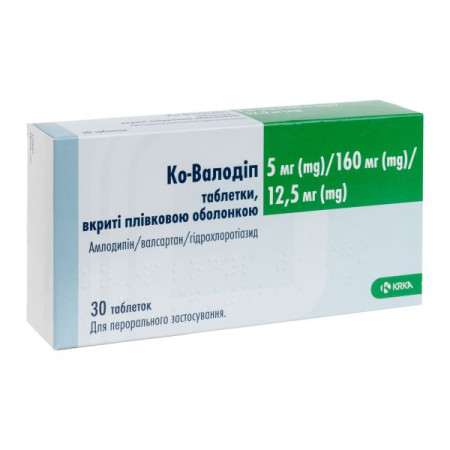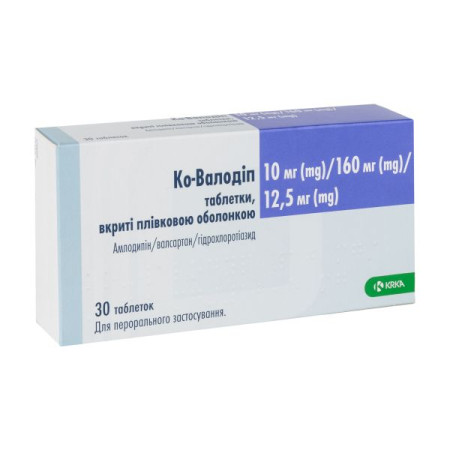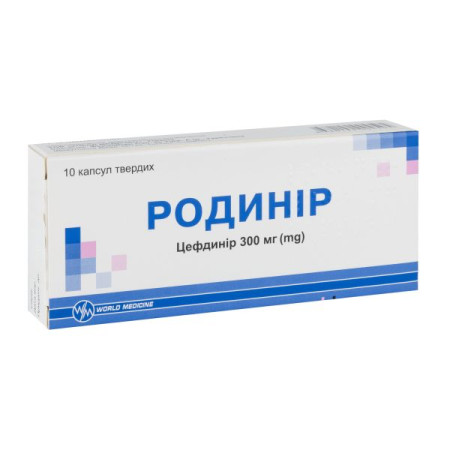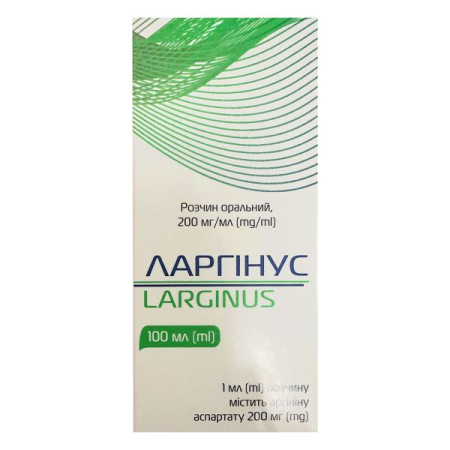Prenelia tablets 8mg No. 30
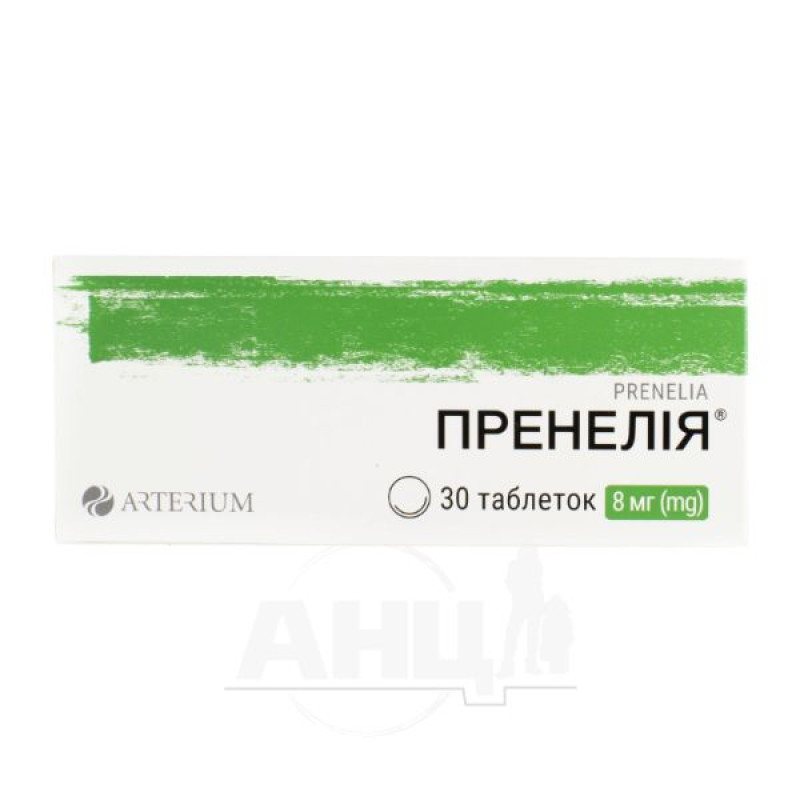
Instructions for Prenelia tablets 8mg No. 30
Composition
active ingredient: perindopril;
1 tablet of Prenelia®, 4 mg contains: perindopril tertbutylamine – 4.0 mg, which corresponds to 3.338 mg of perindopril;
1 tablet of Prenelia®, 8 mg contains: perindopril tertbutylamine – 8.0 mg, which corresponds to 6.676 mg of perindopril;
Excipients: lactose monohydrate; microcrystalline cellulose; silicon dioxide
colloidal anhydrous; magnesium stearate.
Dosage form
Pills.
Main physicochemical properties:
Prenelia®, 4 mg: White or almost white, capsule-shaped tablets with a biconvex surface, scored on both sides.
Prenelia®, 8 mg: White or almost white, round tablets with a biconvex surface.
Pharmacotherapeutic group
Angiotensin-converting enzyme (ACE) inhibitors, monocomponent. Perindopril.
ATX code C09A A04.
Pharmacological properties
Pharmacodynamics
Perindopril is an inhibitor of the enzyme that converts angiotensin I to angiotensin II (angiotensin-converting enzyme ACE). The converting enzyme (or kinase) is an exopeptidase that enables the conversion of angiotensin I to the vasoconstrictor angiotensin II and also causes the breakdown of the vasodilator bradykinin to an inactive heptapeptide. Inhibition of ACE leads to a decrease in the concentration of angiotensin II in the blood plasma, which increases the activity of plasma renin (by inhibiting the negative feedback on renin release) and reduces the secretion of aldosterone. Since ACE inactivates bradykinin, inhibition of ACE also leads to an increase in the activity of the circulating and local kallikrein-kinin system (and thus also leads to the activation of the prostaglandin system). This mechanism of action is responsible for the blood pressure lowering effect of ACE inhibitors and is partly responsible for some of their side effects (e.g., cough).
Perindopril tert-butylamine acts through its active metabolite, perindoprilat. Other metabolites do not demonstrate ACE inhibitory activity under experimental conditions.
Arterial hypertension.
Perindopril effectively lowers blood pressure in all degrees of arterial hypertension: mild, moderate and severe; a decrease in systolic and diastolic blood pressure is observed both in the supine and standing positions.
Perindopril reduces peripheral vascular resistance, which leads to a decrease in blood pressure. As a result, peripheral blood flow increases without affecting heart rate.
Typically, renal blood flow also increases, while glomerular filtration rate (GFR) is usually unchanged.
The maximum antihypertensive effect develops 4–6 hours after a single dose and persists for at least 24 hours: the T/P ratio (minimum efficacy/maximum efficacy during the day) of perindopril is 87–100%.
Blood pressure decreases rapidly. In patients who respond to treatment, blood pressure normalization occurs within a month and is maintained without the occurrence of tachyphylaxis.
There is no withdrawal effect when perindopril tert-butylamine is discontinued.
Perindopril reduces left ventricular hypertrophy.
Clinical studies have shown that perindopril has vasodilating properties. It improves the elasticity of large arteries and reduces the ratio of wall thickness to lumen for small arteries.
Add-on therapy with a thiazide diuretic has a synergistic effect. The combination of an ACE inhibitor and a thiazide diuretic also reduces the risk of diuretic-induced hypokalemia.
Heart failure.
Perindopril tert-butylamine reduces heart work by reducing pre- and afterload on the heart.
Studies involving patients with heart failure have demonstrated:
reduction in right and left ventricular filling pressure, reduction in systemic peripheral resistance, increase in cardiac index and improvement in cardiac output.
It is known that in comparative studies, the first administration of 2 mg perindopril to patients with mild to moderate heart failure was not associated with any significant reduction in blood pressure compared to placebo.
Pharmacokinetics
Absorption.
After oral administration, perindopril is rapidly absorbed, with peak plasma concentrations occurring within 1 hour. The plasma half-life of perindopril is 1 hour.
Perindopril is a prodrug. 27% of the total amount of perindopril taken is determined in the blood in the form of an active metabolite - perindoprilat. In addition to the active metabolite - perindoprilat, the drug forms 5 metabolites that are inactive. The maximum concentration of perindoprilat in the blood plasma is reached 3-4 hours after administration.
Food intake reduces the conversion of perindopril to perindoprilat, thus reducing its bioavailability, therefore the daily dose of perindopril tert-butylamine is recommended to be taken once in the morning before meals.
There is a linear relationship between the dose of perindopril and its concentration in the blood plasma. The volume of distribution of unbound perindoprilat is approximately 0.2 l/kg. The binding of perindoprilat to plasma proteins is 20%, mainly to angiotensin-converting enzyme, but this indicator is dose-dependent.
Breeding.
Perindoprilat is excreted in the urine. The terminal half-life of the unbound fraction is approximately 17 hours. Steady-state plasma concentrations are reached within 4 days of initiation of treatment.
Special patient groups.
The elimination of perindoprilat is slowed in elderly patients and in patients with heart or renal failure. It is recommended to select the dose for patients with renal failure, taking into account the degree of insufficiency (creatinine clearance).
Dialysis clearance of perindoprilat is 70 ml/min.
The kinetics of perindopril are altered in patients with cirrhosis: the hepatic clearance of perindopril is halved. However, the amount of perindoprilat formed is not reduced. Therefore, no dose adjustment is required in such patients.
Indication
Arterial hypertension. Heart failure. Prevention of recurrent stroke in patients with cerebrovascular disease. Prevention of cardiovascular complications in patients with documented stable ischemic heart disease. Long-term treatment reduces the risk of myocardial infarction and heart failure.
Contraindication
Hypersensitivity to perindopril or to any of the excipients or to any other ACE inhibitor; history of angioedema after taking an ACE inhibitor; idiopathic or hereditary angioedema; pregnant women, women planning to become pregnant and women of childbearing potential not using adequate contraception (see section "Use during pregnancy and lactation"); concomitant use with sacubitril/valsartan due to increased risk of angioedema;
simultaneous use with drugs containing the active substance aliskiren in patients with diabetes mellitus or renal insufficiency (glomerular filtration rate < 60 ml/min/1.73 m2) (see section "Interaction with other medicinal products and other types of interactions");
extracorporeal treatment that results in blood coming into contact with negatively charged surfaces; significant bilateral renal artery stenosis or stenosis of the artery to a single functioning kidney.
Interaction with other medicinal products and other types of interactions
Drugs that cause hyperkalemia.
Some medicinal products or therapeutic classes of medicinal products may cause hyperkalaemia, such as: aliskiren, potassium salts, potassium-sparing diuretics, ACE inhibitors, angiotensin II receptor antagonists, non-steroidal anti-inflammatory drugs (NSAIDs), heparins, immunosuppressants such as ciclosporin or tacrolimus, trimethoprim. Concomitant use of these medicinal products increases the risk of hyperkalaemia.
The concomitant use of perindopril with aliskiren is contraindicated (see section "Contraindications") in patients with diabetes mellitus or patients with impaired renal function due to an increased risk of hyperkalemia, worsening of renal function, cardiovascular morbidity and mortality and is not recommended (see section "Special warnings and precautions for use") in all other patient groups. Dual blockade of the renin-angiotensin-aldosterone system (RAAS) through the combined use of ACE inhibitors and angiotensin II receptor blockers Published data indicate that in patients with established atherosclerosis, heart failure or diabetes mellitus with target organ damage, the concomitant use of ACE inhibitors and angiotensin receptor blockers was accompanied by an increased incidence of arterial hypotension, syncope, hyperkalemia and worsening of renal function (including acute renal failure). insufficiency) compared with monotherapy with drugs that affect the renin-angiotensin-aldosterone system. Dual blockade (i.e. the combination of an ACE inhibitor with angiotensin II receptor antagonists) may be used in individual cases with careful monitoring of renal function, potassium levels and blood pressure.
Extracorporeal treatment leads to contact of blood with negatively charged surfaces, such as high-flux membranes for dialysis or haemofiltration (e.g. polyacrylic membranes) and for low-density lipoprotein apheresis with dextran sulphate, which may lead to an increased risk of severe anaphylactoid reactions (see section 4.3). If such treatment is necessary, the use of a different type of dialysis membrane or the use of a different class of antihypertensive drug should be considered.
Potassium-sparing diuretics (e.g. triamterene, amiloride and others), potassium salts: hyperkalemia (possibly fatal), especially in patients with renal insufficiency (additive hyperkalemic effect). These drugs are not recommended for concomitant use with perindopril (see section "Special warnings and precautions for use"). However, if concomitant use of these substances is necessary, they should be used with caution and with frequent monitoring of plasma potassium. Regarding the use of spironolactone in heart failure, see "Concomitant use requiring special attention".
Lithium. Reversible increases in plasma lithium concentrations and toxicity have been reported when ACE inhibitors are used with lithium preparations. It is not recommended to use perindopril with lithium preparations. If such use is necessary, careful monitoring of plasma lithium levels is mandatory.
mTOR inhibitors (e.g. sirolimus, everolimus, temsirolimus): Patients receiving concomitant mTOR inhibitors may be at increased risk of developing angioedema (see section 4.4).
Concomitant use requiring special attention.
Epidemiological studies suggest that the concomitant use of ACE inhibitors and hypoglycemic agents (insulin, oral hypoglycemic agents) may lead to an increased hypoglycemic effect with a risk of hypoglycemia. This phenomenon may occur most often in the first weeks of combined treatment and in patients with renal insufficiency.
Baclofen enhances the antihypertensive effect. Blood pressure and renal function should be monitored and the dose adjusted if necessary.
Diuretics: In patients taking diuretics, and especially in those with impaired water and electrolyte metabolism, an excessive decrease in blood pressure may occur after starting treatment with an ACE inhibitor. The likelihood of developing a hypotensive effect is reduced by discontinuing the diuretic, increasing circulating blood volume, or salt intake before starting perindopril therapy, which should be started at a low dose and gradually increased.
In hypertension, when a previously prescribed diuretic may have caused water/electrolyte depletion, it should be discontinued before starting treatment with an ACE inhibitor (in such cases, the diuretic may be resumed over time) or an ACE inhibitor should be prescribed at a low dose with gradual titration.
In congestive heart failure on diuretic therapy, the ACE inhibitor should be initiated at the lowest dose, possibly after a reduction in the diuretic dose. In any case, renal function (creatinine levels) should be monitored during the first weeks of ACE inhibitor therapy.
Potassium-sparing diuretics (eplerenone, spironolactone). Special care is required when eplerenone or spironolactone at doses of 12.5 mg to 50 mg per day are used concomitantly with low doses of an ACE inhibitor. If the recommendations for the appointment of such a combination are not followed, there is a risk of hyperkalemia (possibly fatal) during the treatment of patients with NYHA class II-IV heart failure and an ejection fraction < 40%, who were previously treated with an ACE inhibitor and a loop diuretic. Before prescribing such a combination, it is necessary to ensure the absence of hyperkalemia and impaired renal function. It is recommended to carefully monitor potassium and creatinine weekly during the first month of treatment and monthly thereafter.
Non-steroidal anti-inflammatory drugs (NSAIDs), including acetylsalicylic acid ≥ 3 g/day. A reduction in the antihypertensive effect may occur when ACE inhibitors are used concomitantly with NSAIDs such as: acetylsalicylic acid at anti-inflammatory doses, COX-2 inhibitors, non-selective NSAIDs. Concomitant use of ACE inhibitors and NSAIDs may increase the risk of worsening renal function, including the possibility of acute renal failure, and an increase in plasma potassium, especially in patients with a history of impaired renal function. This combination should be administered with caution, particularly in elderly patients. Patients should be rehydrated and advised to monitor renal function after initiation of combination therapy and during subsequent treatment.
Concurrent use requiring attention.
Medicinal products affecting the sympathetic nervous system: β-blockers enhance the hypotensive effect of perindopril.
Antihypertensives and vasodilators: Concomitant use of antihypertensives may increase the hypotensive effect of perindopril. Concomitant use with nitroglycerin and other nitrates or with other vasodilators may contribute to an additional decrease in blood pressure.
Dipeptidyl peptidase-IV (DPP-IV) inhibitors (linagliptin, saxagliptin, sitagliptin, vildagliptin): Patients receiving a combination of a gliptin and an ACE inhibitor are at increased risk of angioedema. Concomitant use of certain anaesthetics, tricyclic antidepressants or antipsychotics with ACE inhibitors may lead to further reduction in blood pressure (see section 4.4).
Gold: A nitrate-like reaction (symptoms include facial flushing, nausea, vomiting, and hypotension) has been reported rarely in patients receiving concomitant ACE inhibitors, including perindopril, and injectable gold (sodium aurothiomalate).
Digoxin: pharmacokinetic studies have shown that perindopril, when administered concomitantly, does not affect the plasma concentration of digoxin, but an effect of digoxin on the concentration of perindopril/perindoprilat cannot be excluded.
Gentamicin: Animal studies have shown a potential interaction between perindopril and gentamicin. However, the interaction has not been studied in humans.
Neutral endopeptidase inhibitors: Concomitant use of ACE inhibitors and neutral endopeptidase inhibitors increases the risk of angioedema. Patients receiving neutral endopeptidase inhibitors and starting perindopril and vice versa should be closely monitored.
Food interactions. Concomitant administration of perindopril with food does not affect the rate or extent of absorption of perindopril. However, the degree of biotransformation of perindopril to perindoprilat is reduced by 35%, therefore perindopril is recommended to be taken before meals.
Application features
Hypersensitivity/angioedema.
Rare cases of angioedema of the face, extremities, lips, mucous membranes, tongue, glottis and/or larynx have been reported in patients receiving ACE inhibitors, including perindopril tert-butylamine (see section 4.8). This may occur at any time during treatment. In such cases, the drug should be discontinued immediately and the patient should be monitored until symptoms resolve. In those rare cases where the swelling is limited to the face and lips, the patient's condition usually improves without treatment. Antihistamines may be useful in reducing symptoms.
Angioedema associated with laryngeal edema can be fatal. In cases where edema involves the tongue, glottis, or larynx, causing airway obstruction, urgent emergency treatment is required, which may include administration of adrenaline and/or airway management.
Concomitant use with mTOR inhibitors, DPP-IV inhibitors, neutral endopeptidase inhibitors
Patients concomitantly treated with mTOR inhibitors (e.g. sirolimus, everolimus, temsirolimus), DPP-IV inhibitors, neutral endopeptidase inhibitors may be at increased risk of developing angioedema (e.g. swelling of the airways or tongue, with or without respiratory impairment) (see section 4.5).
Intestinal angioedema
Rare cases of intestinal angioedema have been reported in patients treated with ACE inhibitors. These patients presented with abdominal pain (with or without nausea or vomiting); in some cases, there was no previous history of facial angioedema and C-1 esterase levels were normal. The diagnosis of intestinal angioedema was made by abdominal computed tomography or ultrasound, or at the time of surgery. Symptoms of angioedema resolved after discontinuation of the ACE inhibitor. Intestinal angioedema should be excluded in the differential diagnosis of patients with abdominal pain taking ACE inhibitors.
Hypotension. ACE inhibitors may cause a decrease in blood pressure. Symptomatic hypotension is less common in patients with uncomplicated hypertension and is more likely in patients who are volume-depleted, taking diuretics, on a salt-restricted diet, undergoing dialysis, experiencing diarrhoea or vomiting, or in patients with severe renin-dependent hypertension (see sections 4.5 and 4.8). Symptomatic hypotension is more likely in patients with symptomatic heart failure, with or without concomitant renal insufficiency. Symptomatic hypotension is most likely to occur in patients with more severe heart failure, who are receiving high doses of loop diuretics, who have hyponatremia or functional renal insufficiency. To reduce the risk of symptomatic hypotension, patients should be closely monitored during initiation of therapy and during dose titration (see sections 4.2 and 4.8). The same precautions apply to patients with ischemic heart disease or cerebrovascular disease, in whom an excessive decrease in blood pressure could result in myocardial infarction or stroke.
If hypotension occurs, the patient should be placed in the horizontal position and, if necessary, intravenously administered 0.9% (9 mg/ml) sodium chloride solution.
Transient hypotension is not a contraindication for further use of the drug, which can usually be used without any problems after restoration of blood volume and increase in blood pressure.
In some patients with congestive heart failure with normal or low blood pressure, perindopril tertbutylamine may cause an additional decrease in systemic blood pressure. This effect is expected and usually does not require discontinuation of the drug. If hypotension becomes systemic, it may be necessary to reduce the dose or discontinue the drug.
Aortic and mitral valve stenosis/hypertrophic cardiomyopathy. As with other ACE inhibitors, perindopril tert-butylamine should be administered with caution to patients with mitral valve stenosis or left ventricular outflow obstruction (aortic stenosis or hypertrophic cardiomyopathy). Vasodilators generally reduce diastolic pressure and therefore coronary pressure without causing a concomitant decrease in myocardial oxygen demand.
Dual blockade of the renin-angiotensin-aldosterone system (RAAS).
There have been reports of hypotension, syncope, stroke, hyperkalemia and renal dysfunction (including acute renal failure), especially with concomitant use of drugs that affect the RAAS. The combination of an ACE inhibitor (ACEI) with an angiotensin II receptor blocker (ARB) or with aliskiren, given the dual blockade of the renin-angiotensin-aldosterone system, is not recommended.
In patients with diabetes mellitus or renal insufficiency (glomerular filtration rate < 60 ml/min/1.73 m2), concomitant administration with aliskiren is contraindicated (see sections “Contraindications” and “Interaction with other medicinal products and other types of interactions”).
Primary aldosteronism: Patients with primary hyperaldosteronism will usually not respond to antihypertensive drugs that act by inhibiting the renin-angiotensin system. Therefore, the use of this drug is not recommended.
Neutropenia/agranulocytosis/thrombocytopenia/anaemia. Neutropenia/agranulocytosis, thrombocytopenia and anaemia have been reported in patients taking ACE inhibitors. Neutropenia is rare in patients with normal renal function and in the absence of other risk factors. Perindopril should be administered with great caution to patients with collagen vascular diseases, immunosuppressants, allopurinol or procainamide, or a combination of these aggravating factors, especially if renal function is impaired. If perindopril is prescribed to such patients, periodic monitoring of the white blood cell count is recommended. Patients should also be advised to report any signs of infection (sore throat, fever).
Liver dysfunction and liver failure
Hepatitis (hepatocellular and/or cholestatic), elevations of hepatic enzymes and/or serum bilirubin have occurred during treatment with ACE inhibitors in patients with pre-existing liver dysfunction, most of which were reversible. Such patients should discontinue the ACE inhibitor and receive appropriate medical evaluation and treatment (see section 4.8).
Anaphylactoid reactions have been reported in patients receiving hemodialysis (e.g., polyacrylonitrile [PAN] membranes) and concomitantly receiving an ACE inhibitor. Dialysis should be discontinued immediately if symptoms such as nausea, abdominal cramps, burning, angioedema, and hypotension develop and are not relieved by antihistamines. In such patients, consideration should be given to using a different type of dialysis membrane or to using a different class of antihypertensive agent.
Anaphylactoid reactions during low-density lipoprotein (LDL) plasmapheresis. Rarely, patients receiving ACE inhibitors may experience life-threatening anaphylactoid reactions during low-density lipoprotein (LDL) plasmapheresis using dextran sulfate. Anaphylactoid reactions can be avoided by temporarily stopping ACE inhibitor treatment before each plasmapheresis.
Anaphylactoid reactions during desensitization therapy. Patients receiving ACE inhibitors during desensitization treatment with bee venom-containing drugs may experience life-threatening anaphylactoid reactions. These reactions can be avoided by temporarily discontinuing the ACE inhibitor, but the reactions may recur if provocation tests are performed carelessly.
Nitrate-like reaction – (symptoms include facial flushing, nausea, vomiting, and hypotension) occurs rarely in patients taking ACE inhibitors, including perindopril, and injectable gold (sodium aurothiomalate).
Perioperative recommendations. During surgery or during anesthesia with drugs that cause hypotension, perindopril may block the secondary formation of angiotensin II in response to compensatory renin release. The drug should be discontinued one day before surgery. If hypotension develops and is considered to be due to this mechanism, the patient's condition can be normalized by increasing the volume of circulating blood.
Kidney failure.
In case of renal insufficiency (creatinine clearance < 60 ml/min), the initial dose of perindopril should be adjusted according to the patient's creatinine clearance (see section 4.2) and then according to the patient's response to treatment. Monitoring of potassium and creatinine is standard practice in such patients (see section 4.8).
Patients with hypertension and renal artery stenosis. In some patients with bilateral renal artery stenosis or stenosis of the artery to a solitary kidney, increases in blood urea and serum creatinine have been observed during treatment with ACE inhibitors, which usually return to normal after discontinuation of treatment. This is especially true in patients with renal insufficiency. In the presence of concomitant renovascular hypertension, the risk of severe hypotension and renal insufficiency increases. In such patients, treatment should be initiated under close medical supervision with low doses and with careful dose titration. Given the above, diuretic treatment may contribute to the development of arterial hypotension, so they should be discontinued and renal function should be monitored during the first weeks of treatment with perindopril tert-butylamine.
In some hypertensive patients with no known renovascular disease prior to treatment, increases in blood urea and serum creatinine, usually minor and transient, have occurred, particularly when perindopril tertbutylamine was administered concomitantly with a diuretic. However, this is more likely to occur in patients with pre-existing renal impairment. A reduction in dose and/or discontinuation of the diuretic and/or perindopril tertbutylamine may be necessary. In some cases, discontinuation of one or both drugs may be necessary.
Proteinuria.
Hyperkalemia: Increases in serum potassium have been observed in some patients with risk factors while taking ACE inhibitors, including perindopril tert-butylamine. Risk factors for hyperkalemia include renal failure, worsening of renal function, age (>70 years), diabetes mellitus, intercurrent conditions such as dehydration, acute cardiac decompensation, metabolic acidosis, and concomitant use of potassium-sparing diuretics (e.g. spironolactone, eplerenone, triamterene or amiloride), potassium supplements or potassium-containing salt substitutes; or those patients taking other drugs that cause increases in serum potassium (e.g. heparin). The use of potassium supplements, potassium-sparing diuretics or salt substitutes containing potassium, especially in patients with impaired renal function, may lead to significant increases in serum potassium. Hyperkalemia may lead to serious, sometimes fatal arrhythmias. If the concomitant use of perindopril and any of the above substances is considered appropriate, they should be used with caution and with frequent monitoring of serum potassium (see section "Interaction with other medicinal products and other forms of interaction").
Renovascular hypertension.
When ACE inhibitors are prescribed to patients with bilateral renal artery stenosis or stenosis of the artery to a single functioning kidney, there is an increased risk of hypotension and renal failure (see section 4.3). Diuretic treatment may be a beneficial factor. Loss of renal function may be manifested by minimal changes in serum creatinine levels even in patients with stenosis of the artery to a single kidney.
Patients after kidney transplantation: There is no experience with the administration of perindopril tert-butylamine to patients after a recent kidney transplantation.
Race: ACE inhibitors are more likely to cause angioedema in African-American patients than in non-African-American patients, possibly because of the lower renin levels in the blood of African-American hypertensive patients.
Diabetic patients taking oral hypoglycemic agents or insulin should have their blood glucose levels closely monitored during the first month of treatment with ACE inhibitors (see section 4.5).
Lithium: The concomitant use of lithium and perindopril is generally not recommended (see section 4.5).
The concomitant use of perindopril with potassium-sparing medicinal products, potassium-containing food supplements or potassium-containing salt substitutes is not recommended (see section "Interaction with other medicinal products and other types of interactions").
Cough. As with other ACE inhibitors, a dry, persistent cough may occur, which usually resolves only after discontinuation or dose reduction. This possibility should be kept in mind in the differential diagnosis of cough. Cough is often worse when lying down or at night, and is more commonly reported by women (2/3 of cases). Patients who develop cough probably have increased bronchial reactivity. Most cases of cough in non-smokers may be due to smokers having a higher tolerance to cough. The cough is most likely due to the accumulation of kinins (bradykinin) and/or prostaglandins due to ACE inhibition. If the patient develops an intolerable cough, the ACE inhibitor should be changed to another, or if the reaction recurs, to another class of antihypertensive drugs.
Skin reactions: Maculo-papular rash and, less commonly, photosensitivity reactions have been reported with other ACE inhibitors. Severe skin reactions (lichenoid eruptions, psoriasis, pemphigus, rosacea, Stevens-Johnson syndrome) have been reported rarely. If a patient develops a skin reaction, it is not advisable to switch to another ACE inhibitor because of the possibility of cross-reactivity.
Elderly patients. Although clinical experience has not shown differences in the response to treatment between elderly patients (> 65 years) and younger patients, a greater sensitivity to treatment cannot be excluded. Since elderly patients are more likely to have renal insufficiency, treatment should be started with a dose of 2 mg and the patient should be closely monitored during the initial phase of treatment. In a study involving 91 patients with a mean age of 71.9 years, 6% of patients experienced an increase in serum potassium. This occurred within the first month of treatment and subsequently the potassium level remained stable. Blood urea, creatinine or creatinine clearance values were not changed. Perindopril should be administered with particular caution to elderly patients with congestive heart failure who have renal and/or hepatic insufficiency.
Patients with diabetes
In diabetic patients receiving oral hypoglycemic agents or insulin, glycemia should be closely monitored during the first month of treatment with an ACE inhibitor.
Monitoring laboratory tests
Periodic monitoring of white blood cell counts is recommended in patients with systemic connective tissue diseases such as systemic lupus erythematosus or systemic scleroderma, and in patients receiving drugs with known nephrotoxic or myelosuppressive effects (immunosuppressive therapy, treatment with allopurinol or procainamide), or a combination of these factors.
Monitoring kidney function
Routine monitoring of potassium and creatinine is part of normal medical practice for patients with renal impairment (creatinine clearance <60 mL/min).
Particularly careful monitoring is required in patients with hypertension and renal artery stenosis. In such patients, renal function should be monitored during the first few weeks of therapy.
Electrolyte monitoring
When used concomitantly with potassium-sparing diuretics, potassium-containing drugs, potassium-containing salt substitutes, drugs that may increase serum potassium, or other PAAC inhibitors, regular monitoring of serum potassium and urea is considered appropriate.
Excipients.
There are no reviews for this product.
There are no reviews for this product, be the first to leave your review.
No questions about this product, be the first and ask your question.





